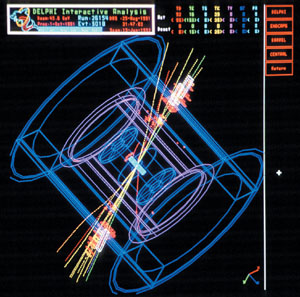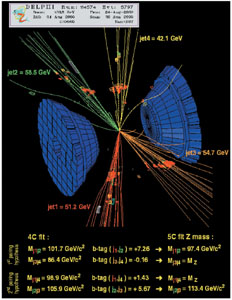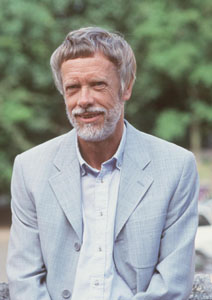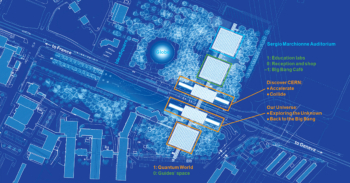It is not true that particle physics – the underlying mechanisms of the universe – can only be understood after a long and difficult apprenticeship. To reach out and appeal to young students, Erik Johansson, a CERN researcher from Stockholm, prefers to cut through conventional formalism to reveal what happens when elementary particles collide.
Elementary particles are the universe’s simplest constituents, but their interactions are far from simple. When two elementary particles collide, all sorts of things can happen. Viewed through the eye of a big detector, the outcome is usually a convoluted maze of secondary particles and it is difficult to see at first or even at nth glance what is going on. Usually the experiment’s computers have to use complex pattern recognition procedures to join up the individual read-out “dots” and reveal the underlying particle tracks. Even then, additional complex analysis is needed.
Occasionally, however, the interactions recorded by the detector are particularly simple, especially for collision scenarios like those at CERN’s LEP collider, which from 1989 to 2001 threw high-energy beams of electrons and positrons together.

Electrons and positrons, unlike protons, are truly elementary and contain no constituents (at least as far as we know). They are also particle and antiparticle of each other, and they can mutually annihilate to produce another particle-antiparticle pair, such as two oppositely charged muons. These rare but simple processes provide a direct window into the most basic interactions of nature.
The other tool that can be brought to bear is what CERN researcher Erik Johansson calls “topology”. The computers’ pattern-recognition programs can reveal regularities in the way the produced particles emerge. These patterns reflect the elementary particle interactions in a direct way.
If an underlying scheme is not clear, information quickly becomes baffling and incomprehensible. An example is the subway system of a large city like London or Paris. Street maps of big cities are fine for finding one’s way around on foot. They also usually show where the underground stations are, but this does not make clear how the lines are arranged, so it is not easy to plan an underground journey from such a map.
The key is to use a different map, in which the streets have been thrown away and the station dots are connected by different-coloured lines. Immediately, everything becomes clear – to get from A to B, take the red line and transfer at C onto the blue line. The detailed paths taken by the underground lines are not of vital importance to the traveller, only their general direction and interconnections, so such maps are often schematic. This simplification is a great help to understanding.
So it is with elementary particles. The most versatile elementary particles are the quarks, of which there are six varieties, or “flavours”, arranged in three pairs – up and down; strange and charmed; and beauty (or bottom) and top. Quarks are (as far as we know) the ultimate layer in the structure of matter. Substances are made up in turn of molecules, then atoms, then electrons and nuclei, the last being composed of protons and neutrons, and these in turn being built of quarks.

Quarks are different from all of the other constituents of matter. Molecules can be broken into atoms, atoms into electrons and nuclei, and nuclei into protons and neutrons. We know that protons and neutrons are built of quarks, but quarks cannot be isolated. Although we can see that protons or neutrons each contain three quarks, under ordinary conditions, quarks cannot exist on their own as free particles. How, then, can we explore them?
Mapping quark jets
When an electron and a positron annihilate, one possibility is for them to create a quark-antiquark pair (in fact the electron and positron first annihilate into a neutral Z boson, which within 10_24 s materializes into the quark-antiquark pair.) However, because quarks and antiquarks cannot exist as free particles, the emergent quark-antiquark pair manifests itself as two narrow sprays (“jets”) of subnuclear particles. These jets, the progeny of the produced quarks, fly off back-to-back, each jet confined around the direction of the parent quark. Mapping these jets thus reveals how the parent quarks were produced.
An electron and a positron can also produce other quark and antiquark arrangements, both with and without accompanying gluons (the particles that transmit the forces between quarks). Each quark-gluon arrangement produces a characteristic jet pattern. For example, a quark-antiquark pair that is accompanied by a single gluon will produce three jets of subnuclear particles.
These jet patterns, particularly when emphasized by the use of colour, are the quark-gluon physics equivalent of the subway map.
It is rather like monitoring an underground/subway/metro system by watching how the passengers emerge above ground. A burst of passengers means that a train has recently stopped underground.
Johansson’s idea is to select LEP events and prepare them in a way that appeals to 15- to 18-year-old students. He uses electron-positron interactions recorded by the Delphi detector at LEP and presented via a special “Hands-on CERN” Web site. The Web site also contains introductory material and explanations, together with supplementary material about subjects such as particles and their interactions, particle accelerators and Nobel Prizes. The interactions have been “cleaned up” to delete information that is only of interest to physics researchers and optimized for Internet access.

From these displays, students can quickly see how nature works at the most fundamental level. The displays show basic information, such as collision energy, the various particles produced and their energy and momentum. Analysing these collisions does not require any knowledge of quantum chromodynamics or any other exotic concept. Simple billiard-ball kinematics, with maybe a pinch of relativity, is all that is needed.
In this way, students all over the world can access frontier research data, but nothing can substitute for a visit to a major accelerator laboratory. Only in this way can students fully appreciate what large and complex instruments are needed to probe the smallest constituents of matter. Special programmes of lectures and study are regularly arranged for Swedish students by the Swedish Research Council secretariat at CERN along with Swedish CERN researchers. During a short stay at CERN, students get first-hand experience of how science works. “That day I thought I found the Higgs boson,” remarked one recent visitor.
Following a suggestion from Johannson, an extra dimension was recently added to a visit during which students from the UK joined their Swedish counterparts at CERN – at a time in their careers that is useful for future networking. These special programmes aim to rectify the lack of exposure to modern physics in many of the school curricula.
Further information
A keyhole to the birth of time
Building on Johansson’s original idea, CERN’s James Gillies and Richard Jacobsson produced an educational CD-ROM physics analysis package for schools. Particle Physics – a Keyhole to the Birth of Time contains the same real data and analysis tools as the “Hands-on CERN” Web site and comes complete with a comprehensive and visually attractive tutorial package. The authors’ goal is to provide a stand-alone product that teachers can use in class without detailed prior knowledge of particle physics. Bielefeld computer scientist Olaf Lenz designed an easily navigable structure and award-winning American cartoonist Nina Paley created the characters – Malard Decoy and Phyllis Ducque – who act as guides through the content of the CD-ROM. The package is available free of charge to schoolteachers on request to the authors at CERN (e-mail James Gillies or Richard Jacobsson.





